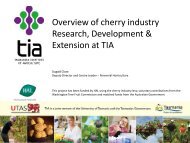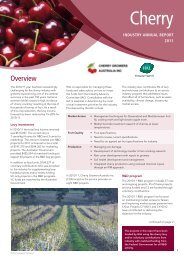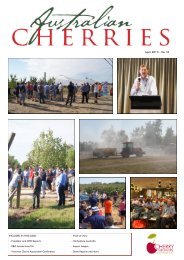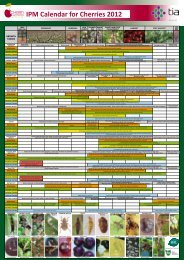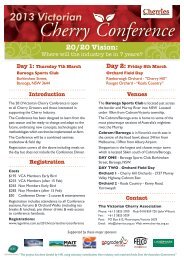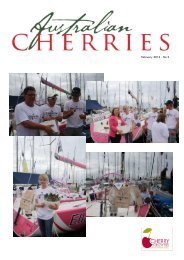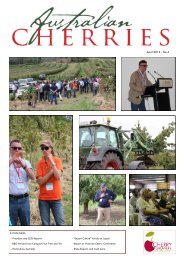annual industry report 08 • 09 - Horticulture Australia
annual industry report 08 • 09 - Horticulture Australia
annual industry report 08 • 09 - Horticulture Australia
Create successful ePaper yourself
Turn your PDF publications into a flip-book with our unique Google optimized e-Paper software.
Verification of a 3°C disinfestation treatment<br />
for nectarines, cherries and plums<br />
Background<br />
In January 2006, the Taiwan Bureau of<br />
Animal and Plant Health Inspection and<br />
Quarantine (BAPHIQ) excluded the entry<br />
of all <strong>Australia</strong>n fresh produce known<br />
to be a host to the Queensland fruit fly<br />
(QFF). Taiwan has been an important<br />
export market for <strong>Australia</strong>n summerfruit<br />
and cherries, and technical submissions<br />
based on QFF disinfestation treatment<br />
protocols for regaining market access were<br />
developed by NSW DPI and provided to<br />
the Taiwanese authorities. The Taiwanese<br />
government required that verification<br />
trials to confirm the efficacy of a 3°C<br />
cold disinfestation treatment for QFF<br />
in fresh cherries, nectarines and plums<br />
be conducted, and that these trials be<br />
overseen by a BAPHIQ Inspector.<br />
Research findings<br />
The three verification trials were<br />
conducted at the NSW Department<br />
of Primary Industries’ QFF research<br />
laboratory at the Gosford Primary<br />
Industries Institute in 20<strong>08</strong>/<strong>09</strong>. One<br />
BAPHIQ inspector was present to<br />
oversee the cherry trial and the beginning<br />
of the nectarine trial, before being<br />
BAPHIQ Inspector removing cherries from QFF cages following infestation.<br />
relieved by another BAPHIQ officer who<br />
oversaw the end of the nectarine trial and<br />
the entire plum trial.<br />
Fresh nectarine, cherry and plum<br />
fruit were infested with QFF eggs by<br />
placing the fruit on top of mesh cages<br />
containing adult QFF. The eggs were<br />
then allowed to hatch and develop to<br />
the most cold-tolerant life stage, which<br />
had been determined during previous<br />
projects (SF05021 and CY05012). For<br />
nectarines and cherries, first instar larvae<br />
were the most cold tolerant, whereas<br />
third instar larvae were the most cold<br />
tolerant life stage in plums. The fruit were<br />
then subjected to a 3°C disinfestation<br />
treatment for 14 days. Following this, the<br />
fruit were removed from the coldrooms,<br />
stored for two to three days at 26°C and<br />
then examined by BAPHIQ inspectors<br />
for any surviving larvae. No QFF larvae<br />
survived in nectarines, cherries or plums<br />
following the 3°C disinfestation treatment<br />
for 14 days.<br />
Industry outcomes<br />
4<br />
BAPHIQ Inspector examining cherry fruit for surviving QFF larvae following treatment at 3°C for<br />
14 days.<br />
This project has been completed and<br />
the final <strong>report</strong> submitted to HAL.<br />
The inspectors present for the trials<br />
have <strong>report</strong>ed back to BAPHIQ and<br />
negotiations are currently underway to<br />
restore market access for <strong>Australia</strong>n<br />
summerfruit and cherries to Taiwan<br />
on the basis of the results of these<br />
verification trials. These trials may also<br />
provide supporting evidence for other<br />
export submissions.<br />
Project MT<strong>08</strong>053<br />
For more information contact:<br />
Katina Lindhout, NSW DPI<br />
T 02 4348 1965<br />
E katina.lindhout@dpi.nsw.gov.au



